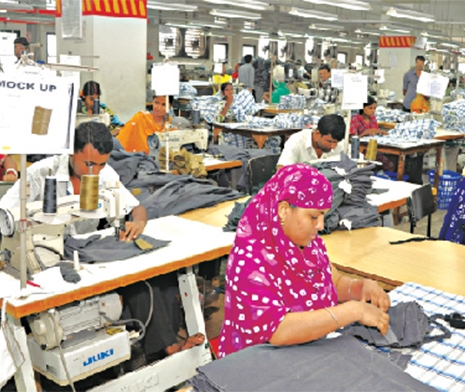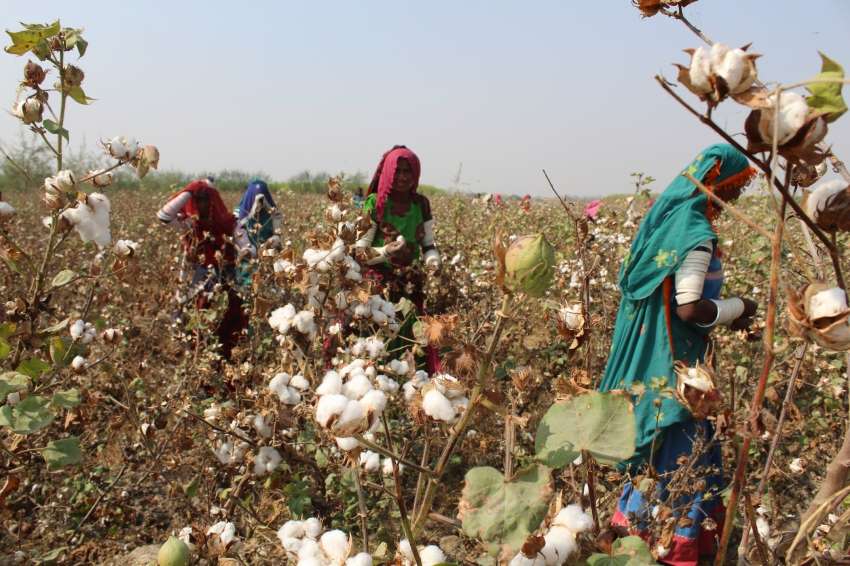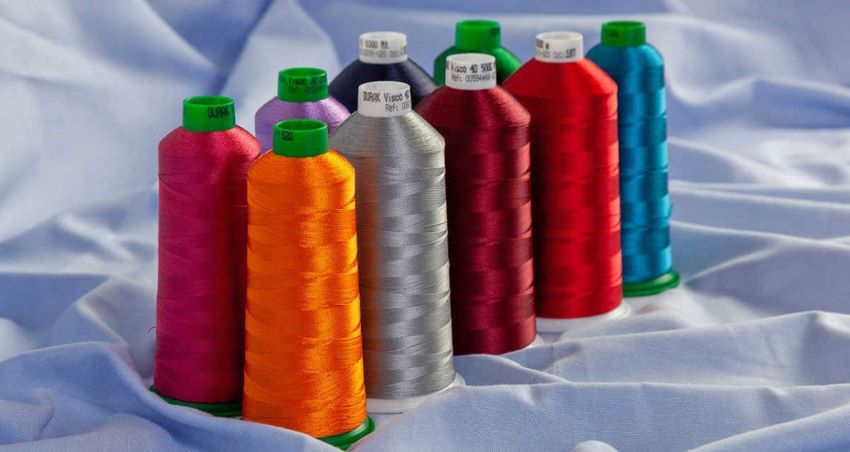FW
Munich Fabric Start for Spring/Summer 2016 season to held from February 2 to 4, 2015, will see over 900 international suppliers from 35 countries presenting their portfolio of 1,500 collections. On display will be the latest developments and innovations in apparel fabrics, dressing, finishing and technology from well-established manufacturers, weavers, printers and textile service providers.
The ‘Fabrics’ segment will feature latest fabric developments and innovations from some 600 suppliers and the Additionals area will showcase latest accessories from about 180 manufacturers. Rounding off the line-up of ranges at the fair will be the comprehensive ‘Colour Forum’ and the ‘Trend Areas’, providing every bit of information and all the components the fashion industry needs for a successful launch into the new season. Nearly 20,000 international trade visitors are expected, including buyers, designers and product managers representing famous brands to source everything they need to design their women’s and men’s collections.
The latest in denim and sportswear developments and finishes will be on display at the Bluezone, a show-in-show at Munich Fabric Start. Titled Denim Extremes, the Spring/Summer 16 Bluzone will feature a line-up of about 80 international denim weavers, finishers and washers. Leading brands such as Candiani, Isko, Orta Anadolu, Tejidos Royo, Calik and Lanifi cio Europa SNC will be joined by Denim Authority, Industrias Morera Unitin, DNM Textile, Fashion Point and Suryalakshmi Cotton Mills.
Paris-based trend and design studio Monsieur-T will present a creative and inspiring think thank on the Blue Stage at the Bluezone to highlight the company’s specialised knowledge of denim trends. Monsieur-T operates internationally as a brand design and market evaluation consultancy and delivers tailored analyses on seasonal design and sourcing trends to renowned brands. The denim art exhibit staged by ‘Nadel & Pen’ will present pure inspiration and creativity tailored, hand-crafted and made in France. Completing the portfolio would be denim-related products such as flats, corduroy, mill-washed fabrics, accessories and the latest innovations for resource-friendly finishes.
The event has put a particular emphasis on textile industry sustainability for years and built a presentation and exchange platform that is unique in both form and scope: the Eco Village and the organic selection presented inside it. The forthcoming show will once again draw well-known NGOs, certification bodies and experts to the Eco Village, where they will present the latest developments and innovations revolving around sustainable textile production and sourcing. GOTS, IVN, IMO, OEKO-TEX, Fair Wear Foundation, Ceres, bluesign technologies and bioRe will be joined by Fairtrade, WRAP and Cotton made in Africa at the dedicated area on sustainability.
In addition to latest developments in fabrics and findings, Munich Fabric Start will offer a comprehensive supporting program consisting of information-packed seminars, trend lectures and eco talks.
Bahrain's textile and apparel sector has got a seven-month respite as the US government has corrected the expiration date of the US-Bahrain free trade agreement tariff preference level (TPL) to July 31, 2016. Earlier the date for expiration was December 31, 2015.
The correction has been made following attention drawn by Bahrain that the expiration date listed as December 31, 2015, for the 10 years’ TPL clause was incorrect as the free trade agreement was not initiated until August 2006. Hence, the 10-year program should be corrected to expire on July 31, 2016.
The US-Bahrain agreement contains the yarn-forward rule of origin, but the rule was suspended for the first ten years of the agreement with the TPL set at 65 million square meters equivalent. This allowed domestic companies to use raw materials imported from third countries for making products meant for exports to the US and avail of the zero-duty benefit.
Once the TPL expires on the corrected date of July 31, 2016, all textile and apparel trade would come under the yarn-forward principle, and garment makers will need to use yarn or fabric made either in the US or Bahrain to avail of the duty-free facility for export to the US.
Japan is planning a big presence at Milano Unica, Italy to be held from February 4 to 6, 2015. Top Japanese makers will be presented at Milano Unica for buyers all over the world. The essence of Japanese fabrics and accessories is underpinned by dual extremities: high-tech and low-tech. The former centers on the ability to develop raw yarns, as exemplified by leading synthetic companies, while the latter comprises skilled traditional craftsmanship; reflected in a long history of expertise and know-how.
Elaborately manufactured compound fabrics also exist thanks to a combination of extremities. The Japanese aesthetic sensibility is present in the fabric creation. Japan will take the opportunity to promote high quality products and further expand business in an effort to kick start textile branding efforts. It hopes to partner with leading like-minded European producers.
It maybe recalled that in September 2014 Milano Unica edition hosted the Japan Observatory initiative. This project was located in a special area within the exhibition ground, where exhibitors representing the country’s manufacturing excellence presented complimentary fabric, rich in innovation, and mainly dedicated to sportswear technology. The Japanese association grouped operators of the textile and apparel sectors, fashion designers and distributors.
Milano Unica is a textile exhibition held in Italy twice a year. It presents top class products of Italian and European textile manufacturers.
www.milanounica.it/ENG/home.php

A recent study suggests that Bangladesh has lost its appeal as a top RMG market for many global brands because of the political unrest in the country. All three South Asian frontier markets: Sri Lanka, Bangladesh and Pakistan, experienced the steepest declines in corporate sentiment, says the latest WSJ/FSG Frontier Market Sentiment Index released.
In 2014, export earnings registered slow growth due to the impact of political uncertainty and two major industrial accidents viz, Tazreen Fashions fire and Rana Plaza building collapse that claimed several lives. In the first six months of 2014 export earnings registered single-digit growth and in the last five months, the figure registered below one per cent growth. Export earnings in January-June period amounted to $14.42 billion, according to the statistics of the Export Promotion Bureau.

In the second half of 2014 the readymade garment sector straggled with shortfall of order due to non- compliance issues as after Rana Plaza tragedy buyers shifted their orders from the factories housed in shared buildings. The export earnings in the July-November period of 2014 grew by only 0.92 per cent to $12.07 billion. Why Bangladesh is losing appeal Interestingly, export data shows the share of RMG has increased in value terms. In 2009 it was $1,192 million which has gone up to $24,583 million in 2014. In per cent terms it has grown from 78.84 per cent in 2009 to 80.85 per cent in 2014. However, growth percentage has been declining in 2009-’10 growth was 24.91 per cent which has gone down to 4.61 per cent in 2013-’14. One major reason affecting the country’s exports is the ongoing political unrest and the opposition party demanding fresh national elections. Other reason is the slow implementation of infrastructure projects and lack of economic reforms.
Top global brands and retailers are seeking alternatives to Bangladesh as the ongoing blockade is hampering timely shipment of garments. Moreover buyers are not willing to travel to Bangladesh to check samples because of possible arson attacks on vehicles, so they are now asking garment makers to send samples to the US. America is the single largest export destination for Bangladesh's garment. In fiscal 2013-14, Bangladesh exported garments worth $5.14 billion to the US, reveal Export Promotion Bureau data.
Almost 11 garment factories have lost $15.1 million between January 14 and January 24 due to the ongoing blockade, says the Bangladesh Garment Manufacturers and Exporters Association (BGMEA). The losses include order cancellation, discount, air shipment charges, delayed shipment and excess transportation costs. In 2013, the sector had to bear air shipment bills worth Tk 5,000 crores and offer discounts worth Tk 9,000 crores because of political unrest. Garment makers or their representatives are forced to travel to Hong Kong, China, India, Thailand and European nations at their own expenditure to attend meetings that were initially planned to take place in Dhaka, leading to further concerns over the country’s inability to emerge as a strong sourcing nation.
According to Rahul Mehta, President International Apparel Federation & C Clothing Manufacturers Association of India, when it comes to Bangladesh, though garments constitute 85 percent of their exports, buyers are putting pressure on Bangladeshi factories to improve wages, labour and safety standards but the question is when standards improve, will Bangladesh be as competitive as today with many buyers already looking at other sourcing options. Ways to deal with the crisis BGMEA in a recent letter to the Ministry of Commerce (MoC) requested the government to allocate closed and loss-making state-owned enterprises (SoEs) to relocate their factories by creating small-sized apparel zones. The industry body seeks SoEs located near the Dhaka-Chittagong Highway for the purpose.
The idea is to move apparel making factories to safer places quickly. Since SoEs have gas and electricity connections, the factories can begin their apparel production immediately after relocation of units. In the letter the BGMEA mentioned that many of the apparel factories have been partly or fully closed because of the ongoing inspection carried out by different local and foreign agencies to check compliance factors.
Experts opine compliance issues and avoiding the possible political uncertainty will be the key challenges the country will have to focus to up its positioning in global readymade garment sector in 2015. The country’s export earnings largely depend on the RMG sector, so they will have to really work towards managing stability in the sector in the New Year.
www.bgmea.com.bd
Claiming profitability improvement due to restructuring steps taken over the past years and anticipating 2014 turnover at $50 million, German fibre manufacturer Trevira has said that the business in the polyester specialties segment continued in a solid and pleasing fashion for the just completed year.
The flame retardant fibres business at Trevira succeeded in generating volume growth of 4-5 percent over the previous year despite difficult economic background and a continuing slow-down in investment. Growth was achieved both in the traditional textile sector and in technical applications like non-wovens, with the latter showing significant volume rise in the spun-dyed segment. Alongside all this, there are a variety of qualification processes running with North American customers and given a positive conclusion, promises a solid basis for growth in 2015, it added.
Business in flame retardant filaments also made stable progress in 2014, showing a slight rise on the previous year. Trevira also noticed a positive development in textile materials incorporating Trevira low-melt yarns, which are being used in the sun protection and acoustics sectors. It also sees good future prospects for business in Asia, as higher fire safety standards gain more ground there.
According to the fibre producer, Trevira CS is also being used in China, in hotels, the office sector, as well as in public buildings such as theatres. Trevira also introduced a new line of Trevira CS filaments made from 100 per cent recycled bottle chips, which are expected to cover new fields of application. Based on new polymer modifications, these product developments are set to open sales opportunities not only in the contract sector, but also in technical applications and in the private market.
Recognizing the demand and need to have a show to share innovative solutions for the fashion industry, the Fédération is organizing ‘Traffic’, the first B2B trade show at the Carreau du Temple, Paris on November 4 and 5, 2015. With this trade show, the Fédération aims to promote its French and international network of the fashion industry organisations, experts, and service providers.
Led by Daniel Wertel, the Fédération represents the women’s ready-to-wear industry by helping more than 600 companies each year. It assists them in structuring their businesses, expand into export markets, develop their points of sale, and optimize their business strategies. With their day-to-day involvement, the Fédération has been witnessing the industry’s growing demand for assistance in various services and business challenges.
The objectives of the Traffic trade is to facilitate connections between fashion businesses and the professionals, present all existing services, programs, and solutions that target fashion businesses, showcase French and international innovations that serve the fashion industry. Priscilla Jokhoo, the Fédération’s Business Division Director, is in-charge of organising this trade show.
www.salontraffic.com
The recent Kingpins show held in New York from January 20 to 21 highlighted international denim and sportswear fabric mills, wash houses, full package manufacturers, trim suppliers and service and information providers relevant to the industry. The show had 66 exhibitors, sharing the latest in manufacturing and fabric innovation.
Jeanologia displayed the various effects that can be achieved with its state-of-the-art light scraper laser technology. These lasers, which re-create designs and images made in photoshop, can produce everything from standard whiskers to exact duplications of HD photographic images. The company is also hawking a new washing method that saves amounts of water and energy.
Orta Andalou from Turkey showed an extensive range of fabrics. These include categories such as Ultra Flex, a stretch denim with 30 per cent recovery, Body Science, a group with a soft hand thanks to modal, and D Craft, a series of vintage-inspired stretch denims.
Mexico’s Global Denim was also on hand to show its Spring/Summer 2016 collection called Ramp Up. Its highlights include super soft feminine stretch, masculine rigids, masculine stretch and a black, white and gray group.
The next Kingpins will be in Hong Kong, March 24 to 25, 2015.
www.kingpinsshow.com/main/default/s-aboutus.aspx
 The HKTDC Hong Kong Fashion Week for Fall/Winter and the concurrent HKTDC World Boutique, Hong Kong, saw some 1,800 exhibitors from around the world. The four-day extravaganza from January 19 to 22 at the Hong Kong Convention and Exhibition Centre (HKCEC) was based on the theme of “Light Me Up”.
The HKTDC Hong Kong Fashion Week for Fall/Winter and the concurrent HKTDC World Boutique, Hong Kong, saw some 1,800 exhibitors from around the world. The four-day extravaganza from January 19 to 22 at the Hong Kong Convention and Exhibition Centre (HKCEC) was based on the theme of “Light Me Up”.
The fair showcased latest collections from a number of internationally celebrated fashion designers: Hong Kong’s designer duo Eri Chu and Philip Chu; New York designer Loris Diran; an award-winning Chinese fashion designer Wang Yutao from Beijing and Swedish couture fashion designer Lars Wallin. The Hong Kong Fashion Extravaganza for the first time welcomed Audi as its title sponsor. Audi honoured designers who exemplify a dedication to design and craftsmanship via the international platform of the Hong Kong Fashion Extravaganza.
Loris Diran, a New York-based designer with a signature label, attended for the first time. 
Diran describes his collection for men and women as ‘elegant and edgy’. He works with the same theme for men and women. Currently, he retails through Saks Avenue and other select boutiques in the US and Europe. “The objective to participate in The Hong Kong Fashion Extravaganza, is primarily to introduce myself and start a relationship,” says Lorid. He finds it very interesting how Asian brands and companies develop lovely ‘items’ those cannot be generally described as basic but are speciality range even in lower prices. Beauty of the market he observed as trends is digital prints especially in street style, expressing the exotic culture. With big luxury brands like Gucci, Prada and Valentino Jack here and consumers buying unique products and is willing to see newness. The big trend is young men are experimenting and sales have grown from 25 per cent earlier to 38-40 per cent now. “This fashion week is wonderfully organised and not even a single detail is missing”, he sums up.
Shirley Chan, Chairman, Hong Kong Brand Development Council, while addressing a media briefing of overseas journalists said, “HK is not only a production centre but also a growing sourcing centre for clothing. Between January to November 2014, HK exported $18.7 bn worth of clothing and accessories. The US being largest at 37 per cent, EU second at 28 per cent and Japan was the third biggest export destination. She laid importance that clothing business because of fast fashion and others is becoming far more dynamic now, earlier a lead time of 9-12 months used to be there for supplying to brands and retailers, which has reduced to 4-6 months now adding lot of pressure. She said in this edition of HK Fashion Week, the new zones of thermal clothing and functional textiles that have been added are being well received by buyers.
On the second day, the Hong Kong Young Fashion Designers’ Contest 2015 (YDC) was held. The remarkable judge panel included H&M Creative Advisor Margareta van den Bosch of Sweden as the VIP Judge. TV star Chris Lai joined top models Jia Jing, Mikki Yao, Ana R., Alice B and Li Dan Ni as in the show presenting designers’ latest collections. More than 1,000 guests attended the show, among them were celebrities Daniel Chan, Edmond Leung, Ivana Wong, William Tang, Henry Lau, Hilary Tsui and Zing.
The 15th Footwear Design Competition Hong Kong, Knitwear Symphony 2015 & Hong Kong Young Knitwear Designers’ Contest, as well as The Ecochic Design Award 2014/15 Grand Final Fashion Show were held during the fairs. The events also included popular trend forecast seminars by WGSN, Fashion Snoops and other leading fashion consulting agencies.
The event had increased focus on knowledge forums through a wide range of seminars on sustainability, emerging markets of Myanmar, and other key industry topics, as well as masters’ sharing by Margareta van den Bosch, the Creative Advisor of H &M, and a wide range of seminars. In the opening speech of sustainability seminar “Sustainable development of fashion industry: The way forward” Hon. Felix Chung, member of legislative council of HKSAR (textile and garment sector) emphasised on the need for sustainability. He said sustainability is a channel to upgrade global competition and it is critical for HK to remain a sourcing hub for textile and clothing sector and develop HK as Asian knowledge hub of sustainability. HK can play a key role in developing Higgs Index as global sustainability index.
Margareta van den Bosch, the Creative Advisor of H &M, widely known as “mother of the Swedish fashion industry” made a presentation on creative principals of H&M and also showcased videos of various key collaborations with global celebrities that she managed for H&M including with David Beckham, for David Beckham Bodywear at H&M and M by Madonna. She advised today’s designers on how to learn skills and work as intern in the initial years of jobs, even if they want to start their labels, “this will help you to lose less money”, she said humorously. Bosch describes her way of interpreting trends as “As a designer you must keep your eyes, ears, everything open for...celebrity culture, the art, movies and music world”. She also mentioned that I don’t like “fast fashion” as much because it is always going to take as much time to plan, manufacture and to be there.
Another interesting panel discussion “E-Commerce: an exciting opportunity for sustainable fashion?” was organised by Redress, moderated by Christina Dean, Founder and CEO, Redress with panellist from Net-a-Porter, TPassion, UPS and Goodone e-commerce companies. Dean opened the discussion by emphasizing on the need to be sustainable, ecommerce which is currently 5.9 per cent of the total retail market and shall be 8.8 per cent by 2018, should address to the grave concern over the textile and clothing waste being generated millions of tonnes every day, “ Hong Kong alone generates clothing waste of 293 tonnes everyday”, she exclaimed. Panel discussed about the steps being those are being taken even at the level of logistics to reduce miles travelled by delivery staff.
Dedicated zones for clothing categories The Hong Kong Fashion Week had many dedicated zones covering the entire range of buyers’ needs from yarns, fabrics, fashions and accessories to garment-related products and services. There was a new zone this year for thermal clothing featuring apparel ideal for extremely cold weather. The Taiwan Sweater Industry Association showcased thermal yarn, a long-wearing yarn that absorbs and distributes heat evenly. Emporium de Mode was a unique premium section dedicated to presenting stylish and distinctive garments in an elegant setting, while Fashion Gallery displayed high-end fashion collections with an emphasis on quality. Other highlights included Fabrics & Yarn, together with Taiwan Textile Federation, which featured a wide selection of fabrics, fibres, laces and yarns, including eco fabrics and yarn; and World of Fashion Accessories, with the latest in accessories to complement fashion selections.
HKTDC World Boutique A leading showcase for international fashion brands and designer collections in Asia, the event provides a platform dedicated to fashion and lifestyle brands. More than 660 brands from 20 countries and regions took part in this year’s World Boutique, Hong Kong, including first-time participants from Finland, Nepal, New Zealand, South Africa, The Netherlands and the USA. Fashion brands and designers included 2%, Aquascutum, Episode, i.t, Ika Butoni, Jessica, Lu Lu Cheung, Marccain, Moiselle, Shanghai Tang and Zalora.
Many local and overseas industry associations staged runway shows or formed group pavilions at the fair, including the Hong Kong Fashion Designers Association, Indonesian Fashion Designers Association, Japan Fashion Leather Designers, Kokusai Fashion Centre, Japan and Taiwan Textile Federation. New pavilions this year included the Fashionally Pavilion, Finland-Hong Kong Trade Association and Thailand Textile Institute. Japan Fashion Leather Designers presented 12 premium brands and Finland-Hong Kong Trade Association showcased collections with 11 designers during the inaugural session.
Bangladesh has a plan to promote jute-based handloom industries in rural areas.
The idea is that these will be run mainly by women and contribute to their empowerment, one result of which would be enhanced exports to international markets. Also promoting jute-based handloom industries is seen as vital for enhancing exports of quality jute products and earning more foreign exchange.
Women would be trained in setting up jute-based cottage and handloom ventures. These entrepreneurs would be provided a package of services like marketing facilities and the necessary capital, support and the latest technologies for producing high valued, quality and diversified jute products.
Jute growing is particularly suited to the poor. Women figure particularly prominently across all levels of the jute industry – as farm laborers and mill workers, and as small businesswomen and employees making and selling jute products.
Known as the golden fiber jute has been traditionally cultivated in the Bengal delta for many years. Around 33 per cent of all jute comes from Bangladesh, making it the world’s second largest jute producer.
Bangladesh is the largest producer of raw jute or jute fiber in the world. Production of jute is highly labor-intensive, creating seasonal employment for 48,000 women on the land.
Jean-Maurice Ferauge has been appointed director of Lectra Japan. He will be responsible for developing Lectra’s presence in Japan, particularly in the automotive and fashion industries. He will also consolidate Lectra’s value proposition in the field of services.
Férauge has extensive experience in successfully managing far reaching projects throughout the whole world, particularly in Japan. He is a mechanical engineer. He worked for nine years in the aerospace industry. He will be responsible for strengthening Lectra’s Japanese teams by continuing the recruitment of new talents.
Lectra has been in Japan for 30 years. Lectra already supports a lot of customers in Japan, including the major automotive suppliers, as well as the largest fashion industry brands, with its expertise and highly advanced technology such as its product lifecycle management solution.
Over the past few years, Lectra has placed the development of professional services at the heart of its priorities. Lectra is the world leader in integrated technology solutions dedicated to industries using soft materials--fabrics, leather, technical textiles and composite materials.
Lectra develops the most advanced specialized software and cutting systems and provides associated services to a broad array of markets including apparel, accessories, footwear, car seats and interiors, airbags, furniture as well as a wide variety of other market sectors.
www.lectra.com/












